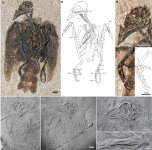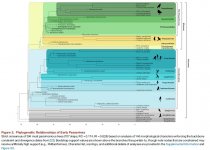Fred Ruhe
Well-known member

Daniel T. Ksepka, Lance Grande, Gerald Mayr, 2019
Oldest Finch-Beaked Birds Reveal Parallel Ecological Radiations in the Earliest Evolution of Passerines
Current Biology 29, 1–7
Highlights
- Finch-beaked bird fossils provide evidence for Eocene passerines with seed-based diets
- Eocene stem passerines underwent a radiation paralleling that of modern passerines
- Stem passerines evolved a wide array of beak shapes but ultimately died out
In Brief
Ksepka et al. report two new fossil bird species which are the oldest birds with a finch-like beak. Phylogenetic analyses reveal that these birds are part of a diverse radiation of early stem passerines (perching birds).
SUMMARY
Beak shape plays a key role in avian radiations and is one of the most intensely studied aspects of avian evolution and ecology [1–4]. Perhaps no other group is more closely associated with the study of beak shape than Passeriformes (passerines or perching birds), the most species-rich ordinal clade of modern birds. However, despite their extraordinary present-day diversity, our understanding of early passerine evolution has been hindered by their sparse fossil record [5, 6]. Here, we describe two new species of early Eocene stem passerines from the Green River Formation of the United States and the Messel Formation of Germany. These species are the oldest fossil birds to exhibit a finch-like beak and provide the earliest evidence for a diet focused on small, hard seeds in crown birds. Given that granivory is a key adaptation that allows passerines to exploit open temperate environments, it is notable that both species occurred in subtropical environments [7, 8]. Phylogenetic analyses place both species within the Psittacopedidae, an extinct Eocene clade of zygodactyl stem passeriforms that also includes the slender-beaked nectarivorous Pumiliornis, the short-beaked Psittacopes, and the thrush-beaked Morsoravis. Our results reveal that stem passerines attained a diversity of beak shapes paralleling many of the morphotypes present in extant passerine finches, thrushes, and sunbirds, more than 35 million years before these morphotypes arose in the crown group. Extinction of these ecologically diverse fossil taxa may be linked to more sophisticated nest construction in anisodactyl crown passerines versus cavity-nesting in Eocene zygodactyl stem passerines [9].
The paper describes:
Eofringillirostrum Ksepka, Mayr, and Grande gen. nov.
Eofringillirostrum boudreauxi sp. nov. (type species).
Eofringillirostrum parvulum sp. nov.
Free pdf: https://www.cell.com/current-biology/pdf/S0960-9822(18)31674-9.pdf
More information will follow.
Enjoy,
Fred
Oldest Finch-Beaked Birds Reveal Parallel Ecological Radiations in the Earliest Evolution of Passerines
Current Biology 29, 1–7
Highlights
- Finch-beaked bird fossils provide evidence for Eocene passerines with seed-based diets
- Eocene stem passerines underwent a radiation paralleling that of modern passerines
- Stem passerines evolved a wide array of beak shapes but ultimately died out
In Brief
Ksepka et al. report two new fossil bird species which are the oldest birds with a finch-like beak. Phylogenetic analyses reveal that these birds are part of a diverse radiation of early stem passerines (perching birds).
SUMMARY
Beak shape plays a key role in avian radiations and is one of the most intensely studied aspects of avian evolution and ecology [1–4]. Perhaps no other group is more closely associated with the study of beak shape than Passeriformes (passerines or perching birds), the most species-rich ordinal clade of modern birds. However, despite their extraordinary present-day diversity, our understanding of early passerine evolution has been hindered by their sparse fossil record [5, 6]. Here, we describe two new species of early Eocene stem passerines from the Green River Formation of the United States and the Messel Formation of Germany. These species are the oldest fossil birds to exhibit a finch-like beak and provide the earliest evidence for a diet focused on small, hard seeds in crown birds. Given that granivory is a key adaptation that allows passerines to exploit open temperate environments, it is notable that both species occurred in subtropical environments [7, 8]. Phylogenetic analyses place both species within the Psittacopedidae, an extinct Eocene clade of zygodactyl stem passeriforms that also includes the slender-beaked nectarivorous Pumiliornis, the short-beaked Psittacopes, and the thrush-beaked Morsoravis. Our results reveal that stem passerines attained a diversity of beak shapes paralleling many of the morphotypes present in extant passerine finches, thrushes, and sunbirds, more than 35 million years before these morphotypes arose in the crown group. Extinction of these ecologically diverse fossil taxa may be linked to more sophisticated nest construction in anisodactyl crown passerines versus cavity-nesting in Eocene zygodactyl stem passerines [9].
The paper describes:
Eofringillirostrum Ksepka, Mayr, and Grande gen. nov.
Eofringillirostrum boudreauxi sp. nov. (type species).
Eofringillirostrum parvulum sp. nov.
Free pdf: https://www.cell.com/current-biology/pdf/S0960-9822(18)31674-9.pdf
More information will follow.
Enjoy,
Fred





